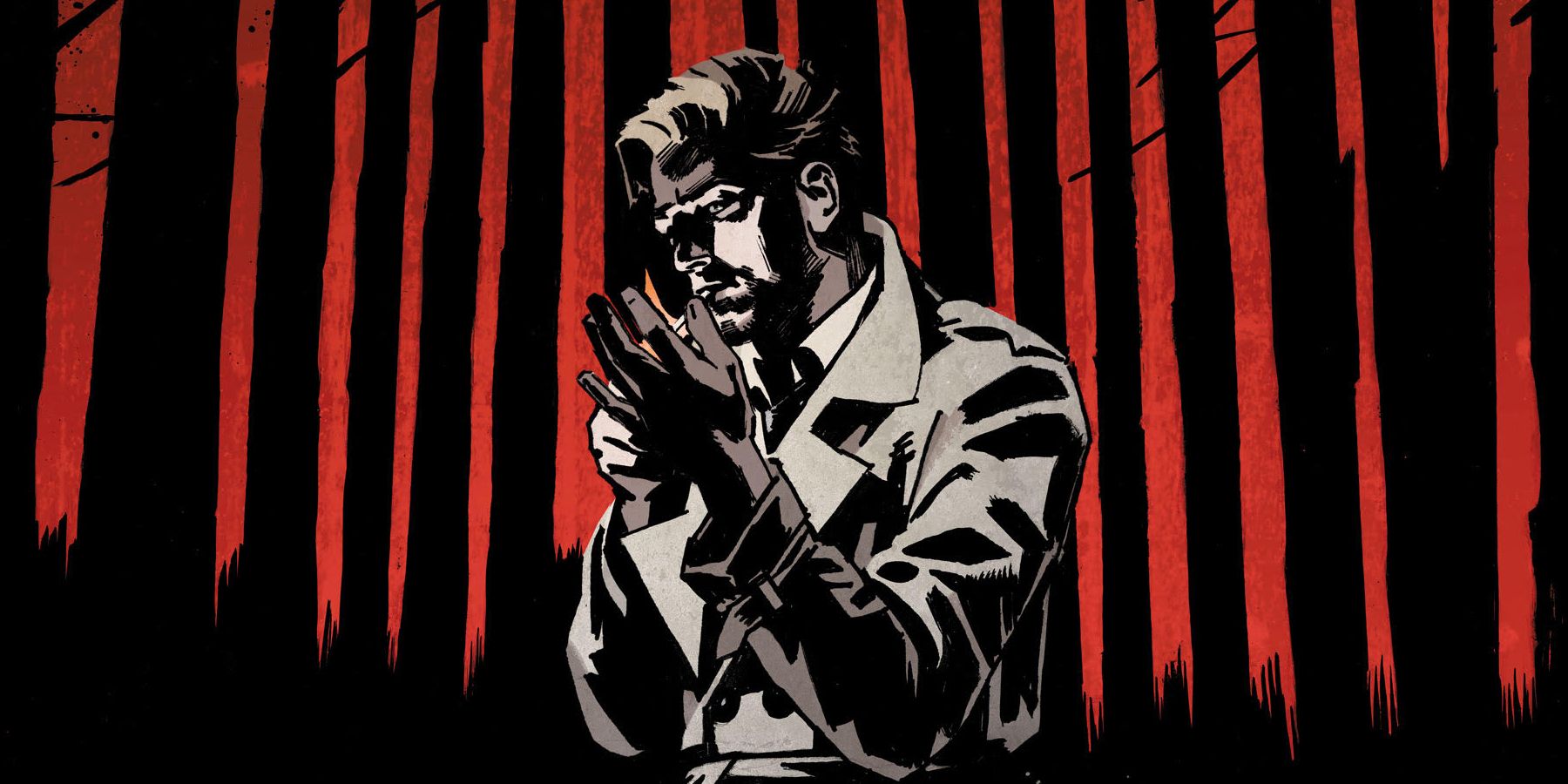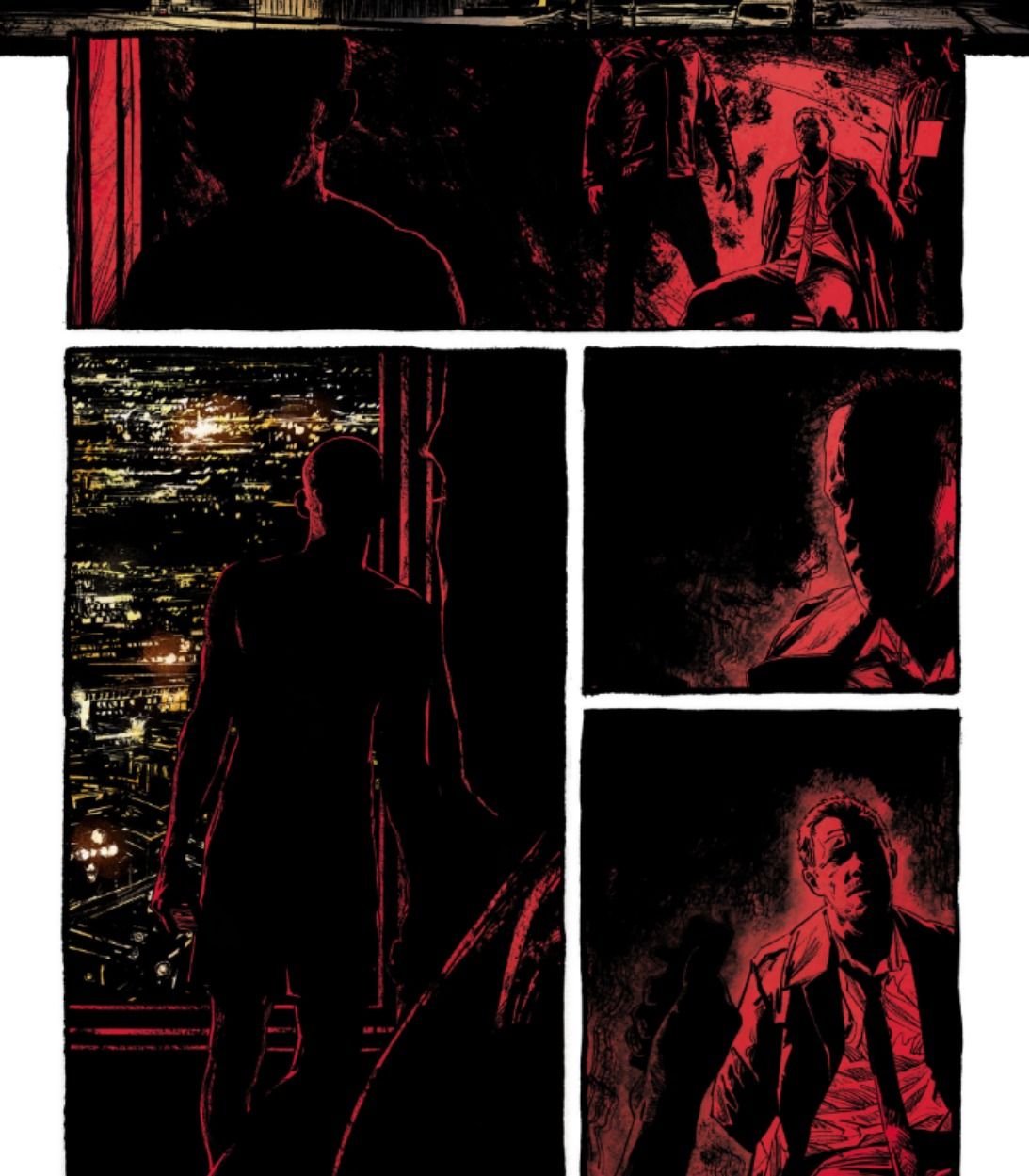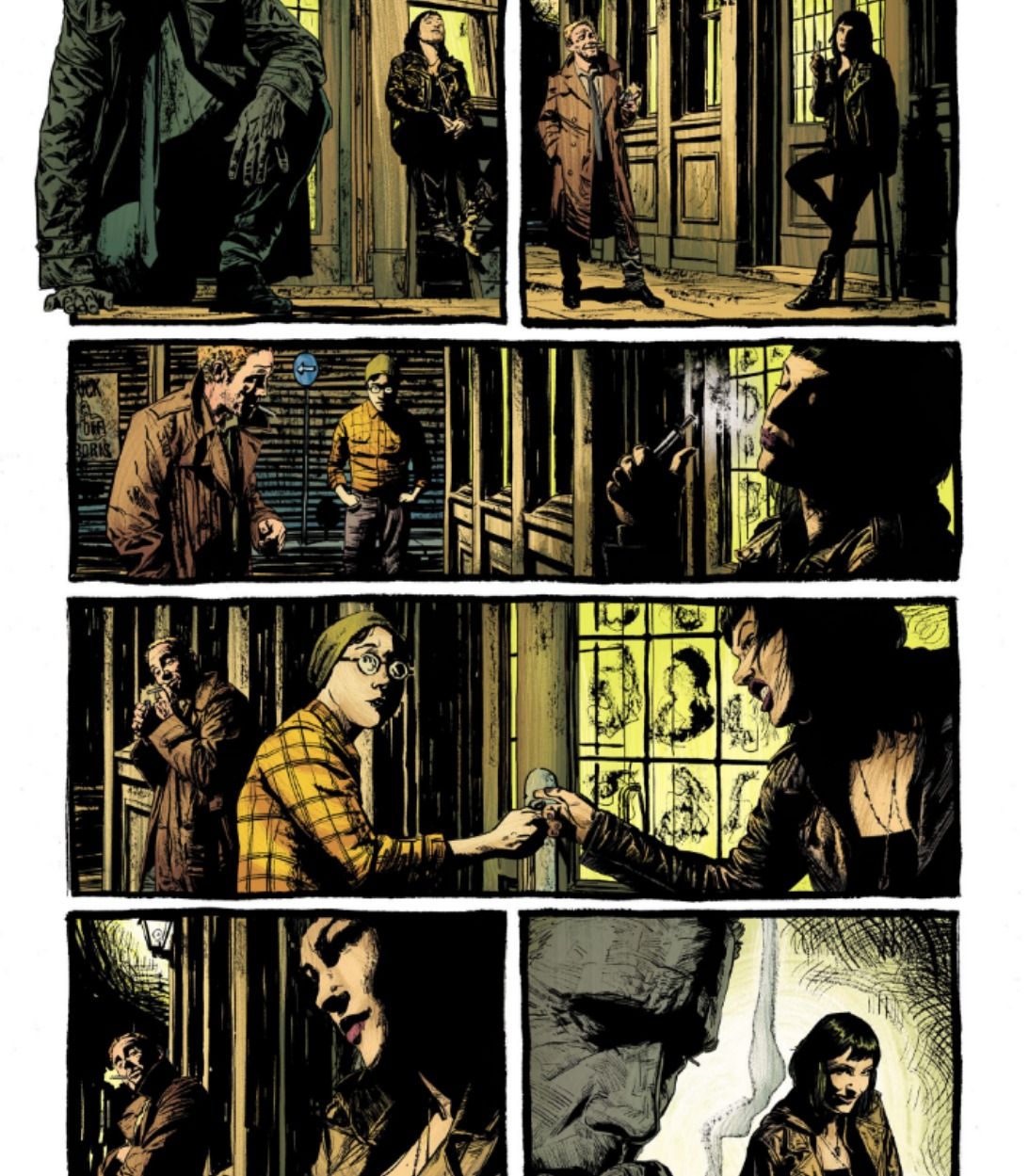John Constantine was one the most iconic occult figures in the DC Universe before becoming the flagship character from the Vertigo Comics imprint. He has thrilled fans for decades as a world-weary, cynical warlock contending with the supernatural -- often at the expense of those around him -- as part of a lifelong attempt at redemption. After a separate special one-shot introducing the timeless, irascible incarnation of the character to Neil Gaiman's Sandman Universe, the acclaimed creative team of Simon Spurrier and Aaron Campbell have launched a new ongoing series, John Constantine: Hellblazer. In it, they take full advantage of the more mature tone and subject matter long-associated with the character since his creation.
Speaking with CBR, Spurrier and Campbell shed light on the new series, how this version of John Constantine differs from that currently active in the main DCU, how they see the character and what enables him to endure in rapidly changing times.
CBR: With this series, John feels a bit out of place in his old stomping grounds. How would you describe John’s links to London, especially now in 2019?
Simon Spurrier: I wouldn’t say he’s out of place -- quite the opposite; London has always been a critical part of his DNA. It’s more that he’s out of people and out of time. The special one-shot we put out in October was designed to disentangle the character’s knotty continuity and restore him to the real world, but it’s not really vital to your understanding or enjoyment of the ongoing series to have read it. All that matters is: John’s been away. And now here he is, back in London in 2019, discovering just how fucked the world has become in his absence.
More importantly, whereas in the past he’s always had access to a seemingly endless list of old friends, acquaintances and lovers to help him do what he does -- and usually to throw them under the bus in the process -- now he’s got nobody. He’s functionally alone for the first time in a long time, so he does what anybody like him (by which I mean: a guilt-riddled manipulator who needs the validation of friendships to distract him from all the horrible things in his mind) would do under these circumstances: he tries to collect new people.
But this is 2019, and his preferred method of doing so -- standing in a pub and telling off-color jokes until someone laughs -- just won’t work anymore.
Bringing Hellblazer to the Sandman Universe, you’re leaning towards mature readers. What makes the title really excel with that harder edge and grit?
Spurrier: I mean, Hellblazer’s literally always leaned towards mature readers, so that part’s not really new. As I’m sure your readers know, there’s been another version of the character more recently introduced into the mainstream DCU. Whereas he’s been involved in some really cracking stories, and is a great addition to the shared world in his own right, he’s not the same John Constantine I grew up reading in Hellblazer.
On a really simplistic level, our John is a somewhat more complicated character -- riddled with contradictions and unbearable self-knowledge -- and there’s an element of character-excoriation at the center of every story. We don’t just accept John on his own terms. We force him to confront his many flaws and either defeat them (rarely) or find a haunted, guilty, ugly way to live with them.
The payoff one gets from taking a slightly more nuanced approach to a character like this is that you can also access a functionally unlimited spectrum of adult themes and stories to match. In the first few arcs alone, we’ll be touching on (amongst other things) some of the most horrific murders ever committed to comics, a magical analysis of a literary genius, the abysmal state of the world and its greedy venal leaders and a tiny little goblin-monster made out of shit. Oh, there’s also a fallen angel stuck in a cellphone. We cover a lot of ground, and very little of it would be a comfortable fit for the DCU.
I guess what I’m keen to stress is that whereas “mature content” definitely does mean lots of wonderfully creative swearing and R-rated visual horror, that’s not all. It also implies a more adult lexicon of preoccupations and character arcs (ranging from the sophisticated to the provocative) around which we tell stories.
Aaron Campbell: Just from an art perspective, I’m not pulling punches. The world of Hellblazer will not be a place for the faint of heart.
As part of the Sandman Universe, will we see much interplay with the imprint’s other titles? What were the origins bringing it to the imprint?
Spurrier: Not much interplay, to be honest. The Sandman Universe isn’t just some ring-fenced shared world with endless crossovers and interconnections. These stories all stand alone but benefit from the occasional bit of cross-pollination. I think the only measurable entanglement on the table right now appears in Books of Magic #14. As a result of the events in the one-shot special which came out last month -- which restores John to our world -- he has some serious anxieties about the moral character of another SU character, Timothy Hunter (a Neil Gaiman creation from the early '90s; a kid fated to become the greatest magic-user in the world). In [Books of Magic] #14, John confronts the kid to see for himself whether the little brat’s worthy or wicked. I co-wrote that issue with regular series scribe Kat Howard, and it’s a really wonderful one-shot, with a clever narrative gimmick.
But, as always with these titles, it’s not vital that you’ve read any of the others in order to enjoy the ongoing Hellblazer series.
Hellblazer’s move into the Sandman Universe came about simply because Neil provided us with the central conceit (detailed in the special one-shot from October), which gave us the excuse to choose which version of John Constantine we wanted to focus on. Having used that to get him back to where we wanted him, there won’t be much other crossover at all. At least, not at first.
I think those of us working behind the scenes tend to think of the Sandman Universe as a safe space to tell mature-theme stories of every conceivable type, without worrying too much about the vicissitudes of in-world continuity. Paradoxically, when you compare it to (say) the DCU, the Sandman Universe is both far more recognizably akin to our own world, and far more limitless in its scope and possibilities. Weird, that.
Stories, basically. That’s what it all comes down to. It’s a universe where the stories are more important than the joints between them.
Back in his hometown, what makes Hellblazer and John so quintessentially British? As a sort of rite of passage title for British writers, what did you want to say with him, Si?
Spurrier: I think John typifies a peculiarly British problem, which is that we often struggle with anything unadulterated. Earnest expressions of emotion usually must, for instance, be undercut by a muttered insult. We’re uncomfortable around schmaltz, and the greatest folk-hero archetype to emerge from that trend is the Working Class Truthsayer -- the diamond-in-the-rough with a serpent’s eye for detail and a sneer for every injustice. That’s John, of course, but there’s more to him than that. Because when you dig a little deeper you realize John is an unsentimental sentimentalist. For all his cynicism and razor-sharp analysis, he’s a crusty old romantic who craves affection.
It would be disingenuous, and not a little restrictive, to pretend I had One Shining Message that I hope to deploy via John. Instead I see him as a key to access a pretty unlimited range of globally-relevant stories and themes. Love, hope, redemption, acceptance, blame, hate. Given the present state of the world it’s perhaps no great surprise that the first macro-arc (composed of multiple smaller stories) is an attempt to distill some of the injustices and conflicts currently rumbling in our collective cultural and psychic spaces into a bitter little truism for John to face up to -- but it’ll be a long and awesome journey getting to that point. After that? I have ideas.
But the important thing is that even though John is the perfect lens onto whatever themes or thoughts you want to examine, he’s also a ridiculously fascinating individual in his own right. The perfect Hellblazer story, [in my opinion], is a fusion of a) satisfying self-contained horror, b) sophisticated and valuable thematic commentary and c) painful dissection of John Constantine.
What’s great is that, however pompous that formula may sound, it can be applied just as easily to a story about poetic angels tearing the skin off drug dealers as it can to a story about demons made of poop and pun-based magic. Horror is really, really flexible.
Si, to put you on the spot a bit, what made Aaron the perfect artist for the job? What’s your collaborative process like?
Spurrier: Aaron comes with an unparalleled pedigree mixing horror, noir and pulp, but I think the most important thing is that he’s a lifelong fan of the character. You can feel that love -- and, like any Constantine fan, the attendant disappointments and discomforts at John’s many flaws -- in ever line. Aaron invests a creeping hauntological beauty into every shadow, and if you’ve checked out his process video you’ll know there’s more than a little magic afoot in his methodology.
Basically, he gets it. That’s pretty much the most any writer can ever hope for from a collaborator.
Aaron, you’re coming off the acclaimed horror miniseries Infidel and you’ve done pulp titles like Green Hornet and The Shadow before. What did you want to bring visually to Hellblazer, in particular, with your own approach?
Campbell: First and foremost, I am concerned with capturing the full character of John Constantine. There is definitely a certain pulp quality to John not unlike The Shadow or Green Hornet. You can see shades of Lamont Cranston and Britt Reid in his brooding demeanor, crass objectivity and just that slight glimmer of goodness. The trench coat alone has become a fetishized symbol for the mythological hard boiled scion of the stoic man’s man of the Western frontier. They kept everything bottled up and hidden away because men like that didn’t show weakness. They squinted in the face of danger and died early of alcoholism.
That’s not really John though. He’s definitely a bastard but he is not without emotion, humor or tenderness even (read Hellblazer #27 “Hold Me”, by Neil Gaiman and Dave McKean). And he definitely can’t just bottle it all the way because he knows that’s all bullshit. Those Sam Spades of the past never really existed. That was all just the posturing of broken men. They just couldn’t admit it the way John can.
So just like an actor in a film I have to be able to capture all of that nuance in his expression, body language and the way he tries to keep everyone just at arm’s length. If you pay close attention you’ll notice that in this first issue John never actually touches or physically interacts with anyone of his own accord. Without getting this stuff just right it’s not John Constantine and it’s definitely not Hellblazer.
The other thing I am very eager to do is continue with my experimentation in technique and media that began with my last book Infidel in which I was combining digital and traditional processes. This is where I hope people really see the influence in my work from the days of artists like Richard Piers Rayner, Dave McKean, Kent Williams, and a host of others who were pushing the boundaries of what comics could look like. And hopefully I can accomplish this in a way that at once feels familiar to the long-term fan while also being contemporary in a way that draws in new readers.
To close it all out, what does John Constantine and the Hellblazer legacy mean to each of you personally? What makes him endure?
Spurrier: He was the first comic book character I ever discovered who felt real. As complicated and fucked-up as any of us. My guess is that “bastard with a conscience” is one of the most compelling recipes in all fiction, because it invites us to both root for and question our protagonist. To me that feels like a far more engaging strategy for giving fiction value -- and a far more useful narrative archetype to be putting before readers -- than propagating the idea that the world can be divided into flawless heroes and irredeemable villains.
Campbell: You know as a kid I was obsessed with this other character, very stoic, very much an outcast, had like these hidden knives in his arms and nobody could hurt him so he was always protected, and no one really knew it but he was the best at what he did. I don’t know, maybe you’re familiar. At any rate he was great wish fulfillment for a nerdy, bullied kid.
But then I discovered Hellblazer early in college and it was a revelation on multiple levels. As an art student, Dave McKean’s and Kent William’s covers reframed my entire outlook on comics and illustration. But then there was Constantine who possessed glimmers of that other character in terms of being an abrasive ass and having the fortitude to endure intense hardship but John felt like a real person. He was deeply flawed and unstable yet still managed to persevere and figure things out. All of the chaotic emotion and conflicting feelings that were dominating 19-year-old me were reflected there in the pages of Hellblazer.
John Constantine: Hellblazer #1 is written by Simon Spurrier and illustrated by Aaron Campbell. It is on sale now from DC.



